 Spud
reviews Paris' 2012 Olympic Bid
Spud
reviews Paris' 2012 Olympic Bid
Spud was shopping for some new aluminum foil one day in early Spring of 2005 when he saw an old friend in the supermarket. The two had met previously back in 1988 when Spud's hometown of Calgary was hosting the Winter Olympics.
The two chatted and got reacquainted. The tater learned that his friend was now on the board of the International Olympic Committee and was charged with selecting host cities. The man told Spud that they were now embroiled in the selection process for the 2012 games, of which New York City, Madrid, Moscow, London and Paris were all competing. Knowing the global traveller that he is, the man asked Spud if he would like to help the IOC in reviewing one of the cities. The commitment would require the potato to travel overseas to Paris where he would review the city's infrastructure and culture of its people to see if it was a worthy candidate to host such a prestigious, worldly event as the Summer Olympics. His recommendation would play a vital role in the final IOC decision.
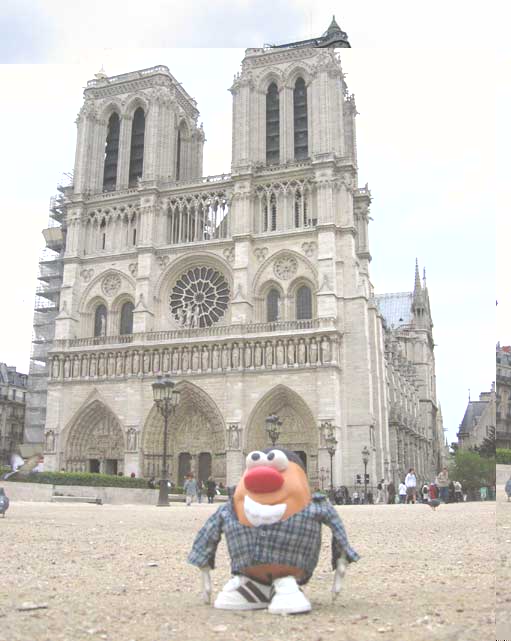 Needless
to say, Spud jumped at the opportunity - not to mention an all-expenses-paid,
free trip!
Needless
to say, Spud jumped at the opportunity - not to mention an all-expenses-paid,
free trip!
The tuber touched down at the Charles de Gaulle airport in Paris on a lovely spring day in April. His review would have him rating the city in a variety of categories, so he wasted no time in getting right to work.
His first item stated that the host city must be welcoming of a mosaic of different cultures, faiths and denominations as it was important to recognize the great diversity of hosting a contingent of well over 100 countries of athletes and spectators. As the tato made his way across town he noted that the city was home to people from many foreign lands and offered many places of worship - most of them very grand in scale, such as the Gothic cathedral of Notre-Dame. The tater noted that the cathedral was completed in the 14th century, proving that the French had recognized the importance of cultural & religious diversity for many years, and hadn't just thrown a few churches up to look good for the IOC.
In addition, while visiting the cathedral of Notre Dame, Spud saw that they had employed a man with a handicap - a large deformed hump on his back. The tater scribbled down some extra marks for the City's workforce diversity and providing equal opportunities for employment
Next up on the list
was to check out Paris' dining establishments. The Olympics would bring
to town millions of visitors, and thus the City must be able to keep them
all fed and watered. Without having to search very long, Spud realized
that there was definitely no shortage of places to eat in the city. The
tuber cruised down Paris' great avenue, the Champs-Elysées, to
test out some of the many cafés and bistros which line the famous
street.
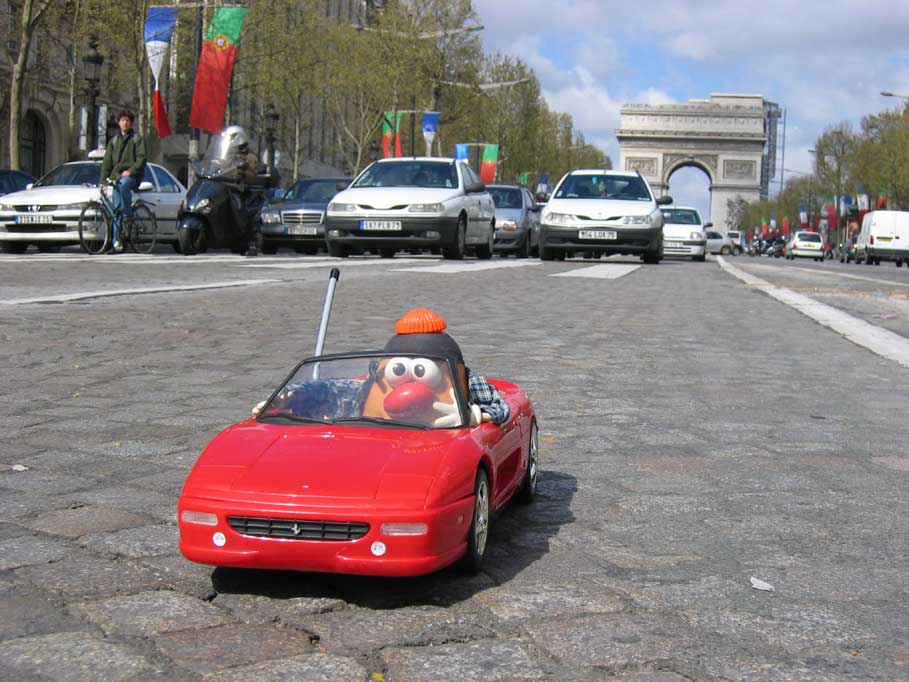 The
tater stopped at a brasserie and ordered a glass of Chardonnay while he
looked at the menu. Feeling like he was being watched, Spud peered over
the top of his wine list and found the Maitre D' talking with the chef;
the chef leering over at the tato's table, clutching a peeler in his right
hand and bubbles of saliva percolating at the corner of his mouth. The
tuber scrambled for his French phrase book to try to figure out what their
discussion was about. As soon as the words “patate frites” came
out of the cook's mouth, he knew it was time to leave.
The
tater stopped at a brasserie and ordered a glass of Chardonnay while he
looked at the menu. Feeling like he was being watched, Spud peered over
the top of his wine list and found the Maitre D' talking with the chef;
the chef leering over at the tato's table, clutching a peeler in his right
hand and bubbles of saliva percolating at the corner of his mouth. The
tuber scrambled for his French phrase book to try to figure out what their
discussion was about. As soon as the words “patate frites” came
out of the cook's mouth, he knew it was time to leave.
Getting away from the tourist mecca, Spud thought he would try to see the real Paris and headed into the local communities to rub shoulders (well, 'ankles') with the locals. The tuber wandered along the stalls of a market in search of the French specialty: the Baguette. He found the local Parisians were much more welcoming of him then the chef at the brasserie. In fact, when Spud tried to buy his french bread, the stall owner embraced the tato and smothered him in kisses. Fortunately Spud's plastic teeth provided a barrier which kept the Parisian's tongue from examining his tonsils...
Aside from the first encounter, the tuber added top marks for the warmth of the locals and quality & quantity of eateries.
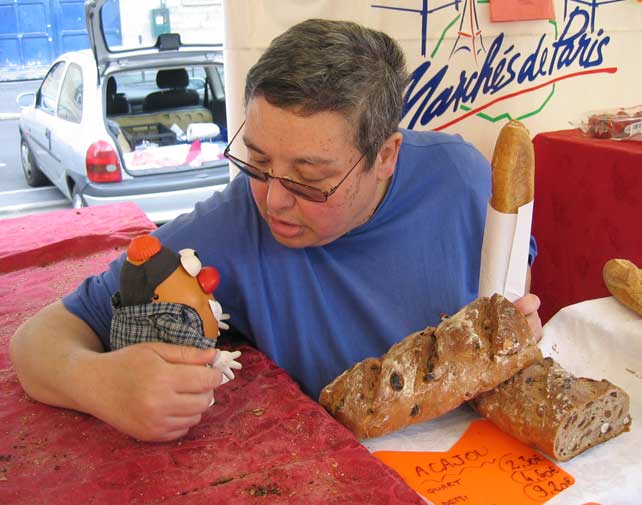 The
Olympics attract millions of visitors to a city and therefore, the transportation
network is key to moving people around from venue to venue. To rate how
well this system works in Paris, Spud jumped into his Ferrari and cruised
around town.
The
Olympics attract millions of visitors to a city and therefore, the transportation
network is key to moving people around from venue to venue. To rate how
well this system works in Paris, Spud jumped into his Ferrari and cruised
around town.
He soon found out
that Parisians drive like contestants in “Death
Race 2000”. Pedestrians do not have the right of way, and apparently
drivers get bonus points if they happen to get a tourist as a hood arnament.
Many intersections are managed by traffic circles (roundabouts), the largest
of which encircles the Arc de Triomphe, the stately monument commissioned
by Napoleon and intricately carved in bas relief to depict famous battles.
The 50m (164 foot) Arc stands in the centre of the roundabout and attempts
to manage the flow of 12 avenues which converge there. With
no lines on the road to identify lanes, Spud took his life into his hands
when he attempted to navigate around the great arch.
After almost an hour and a half driving round and round without a break in the traffic flow to get onto one of the roads, Spud nailed the gas and screamed beneath 6 other cars to get off. Having to give a black mark to the surface roads for transport, he next explored Paris' alternative: The Metropolitain subway (the 'Metro').
The Metro winds its way thru a network of arteries deep beneath the surface of Paris. The tater found navigating was easy and the cars were fast, quiet, clean and infinitely safer than the surface streets.
Upon looking for the subway exit, he opened a door which led to a dark passageway. Spud made a note that this posed a security hazard by not having well-lit exits in the subway.
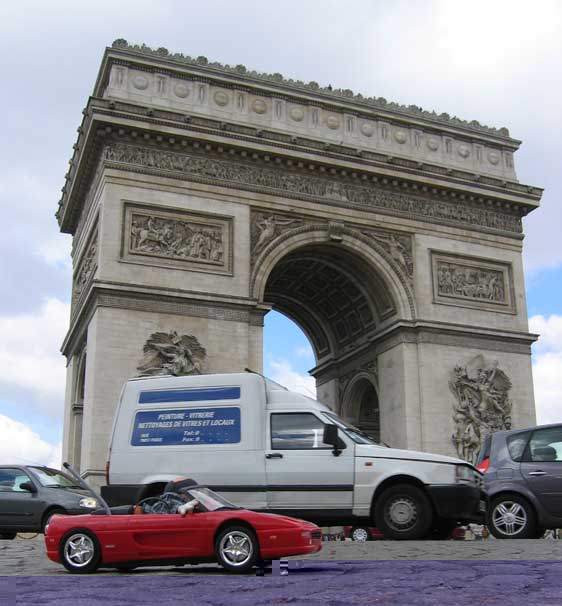 Entering,
the floor was wet and muddy and the passage was eerily quiet; the silence
broken only by the hollow sound of water droplets dripping far down the
black corridor.
Entering,
the floor was wet and muddy and the passage was eerily quiet; the silence
broken only by the hollow sound of water droplets dripping far down the
black corridor.
Using his hand on the wall, Spud guided himself in the subdued light, provided only from the sliver of space space beneath the door he had entered.
As Spud continued he soon realized he was in a labyrinth of interconnected hallways, each shrouded in darkness. Not wanting to get lost, the tater pulled a flashlight out of his rear compartment and turned it on.
The potato gasped horrificly when the light of the torch revealed that the walls were comprised of human bones!! Everywhere he shone the light revealed row upon row of skulls and bones neatly stacked atop one another in a macabre mosaic.
The tater had discovered the city's grisly little secret: the Paris catacombs; a subterranean mass burial ground beneath the city streets
The catacombs were actually depleted limestone quarries which had been used during Roman times as the source of most building material. In the late 18th century, disease was a big problem in certain areas of Paris contributing to (and caused in part) overflowing cemeteries. In 1786, a decision was made to covertly 'relocate' the bones of the dead to these abandoned chambers and hallways beneath the city. The catacombs account for almost 180 miles (300 km) of passgeways housing millions in carefully stacked and organized piles; each labeled with the year of burial.
The potato feverishly scurried down each hall looking frantically for an escape from this living tomb. He finally discovered a ladder to the surface and pushed his way out of a sewer grate.
Worrying that the catacombs may also contain the remains of other prior Olympic Commitee Reviewers, Spud knew exactly how he needed to complete his recommendation report
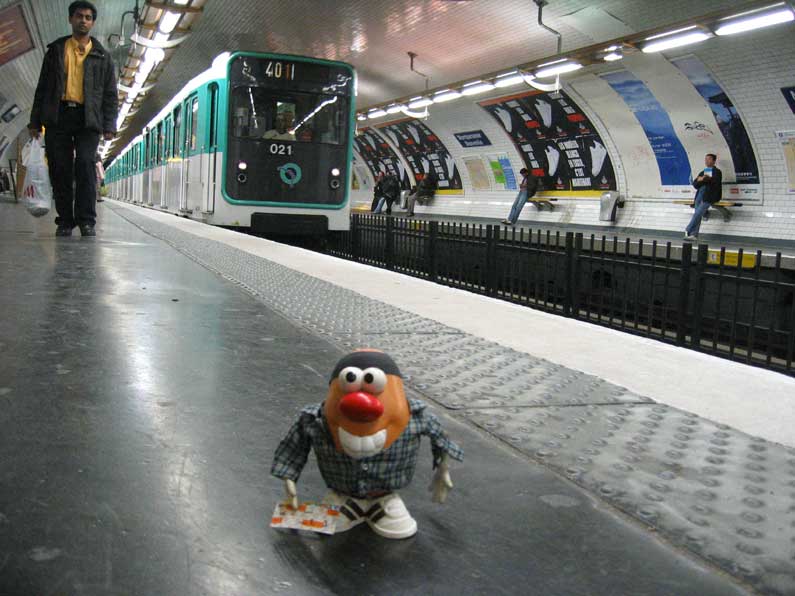
.TOP